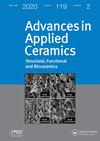The volume erosion rate of the slip cast monolithic and composite ceramics
IF 1.6
4区 材料科学
Q3 MATERIALS SCIENCE, CERAMICS
引用次数: 0
Abstract
ABSTRACT The volume erosion rate of the slip cast monolithic and composite ceramics was studied using SiO2 and SiC particles as erodents, under different impact angles (30°, 60°, 90°), at room temperature. Therefore, three groups of samples were prepared: (i) monolithic alumina (Al2O3); (ii) composite alumina–zirconia (Al2O3–ZrO2) containing 99 wt-% Al2O3 and 1 wt-% ZrO2 and (iii) composite alumina–zirconia (Al2O3–ZrO2) containing 90 wt-% Al2O3 and 10 wt-% ZrO2. Erosion mechanisms of all prepared ceramic samples were evaluated by the volume erosion rate ( , mm3·g–1). Obtained results were compared with the analytical Wiederhorn and Evans equations. The mechanical properties (hardness and fracture toughness) of prepared ceramic samples were compared with their under the above-mentioned conditions. It was found that the erosion of monolithic and composite ceramics increased with the increase of the impact angle. Volume erosion rate was highest at an impact angle of 90° and amounts to 115 mm3·g–1 with SiC, and 12 mm3·g–1 with SiO2 erodent particles for monolithic alumina ceramics, 77 mm3·g–1 with SiC, and 8 mm3·g–1 with SiO2 erodent particles for ceramics with the addition of 1 wt-% of ZrO2, and 61 mm3·g–1 with SiC, and 7 mm3·g–1 with SiO2 erodent particles for ceramics with the addition of 10 wt-% of ZrO2. Therefore, it can be concluded that the erosion resistance of monolithic Al2O3 increases with the increasing amount of ZrO2 in the composite Al2O3-ZrO2 ceramics, thus erosion resistance can be improved with the addition of ZrO2.滑移铸造整体陶瓷和复合陶瓷的体积侵蚀率
在室温条件下,以SiO2和SiC颗粒为侵蚀剂,研究了不同冲击角(30°、60°、90°)下滑移铸造整体陶瓷和复合陶瓷的体积侵蚀速率。因此,制备了三组样品:(i)单片氧化铝(Al2O3);(ii)含有99 wt-% Al2O3和1 wt-% ZrO2的复合氧化铝-氧化锆(Al2O3 - ZrO2)和含有90 wt-% Al2O3和10 wt-% ZrO2的复合氧化铝-氧化锆(Al2O3 - ZrO2)。用体积侵蚀速率(,mm3·g-1)评价了各制备陶瓷样品的侵蚀机理。所得结果与解析式Wiederhorn和Evans方程进行了比较。对制备的陶瓷样品的力学性能(硬度和断裂韧性)与上述条件下的陶瓷样品进行了比较。结果表明,单片陶瓷和复合陶瓷的冲蚀随冲击角的增大而增大。当冲击角为90°时,整体氧化铝陶瓷的体积侵蚀速率最高,SiC为115 mm3·g-1, SiO2为12 mm3·g-1, ZrO2添加量为1 wt-%时,SiC为77 mm3·g-1, SiO2为8 mm3·g-1, ZrO2添加量为10 wt-%时,SiC为61 mm3·g-1, SiO2为7 mm3·g-1。由此可知,Al2O3-ZrO2复合陶瓷中ZrO2的加入量越大,单片Al2O3的耐蚀性越强,因此ZrO2的加入可以提高陶瓷的耐蚀性。
本文章由计算机程序翻译,如有差异,请以英文原文为准。
求助全文
约1分钟内获得全文
求助全文
来源期刊

Advances in Applied Ceramics
工程技术-材料科学:硅酸盐
CiteScore
4.40
自引率
4.50%
发文量
17
审稿时长
5.2 months
期刊介绍:
Advances in Applied Ceramics: Structural, Functional and Bioceramics provides international coverage of high-quality research on functional ceramics, engineering ceramics and bioceramics.
 求助内容:
求助内容: 应助结果提醒方式:
应助结果提醒方式:


